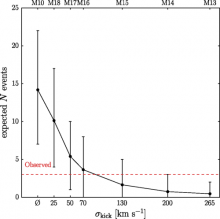
Abstract
We compare binary evolution models with different assumptions about black-hole natal kicks to the first gravitational-wave observations performed by the LIGO detectors. Our comparisons attempt to reconcile merger rate, masses, spins, and spin-orbit misalignments of all current observations with state-of-the-art formation scenarios of binary black holes formed in isolation. We estimate that black holes (BHs) should receive natal kicks at birth of the order of σ≃200 (50) km/s if tidal processes do (not) realign stellar spins. Our estimate is driven by two simple factors. The natal kick dispersion σ is bounded from above because large kicks disrupt too many binaries (reducing the merger rate below the observed value). Conversely, the natal kick distribution is bounded from below because modest kicks are needed to produce a range of spin-orbit misalignments. A distribution of misalignments increases our models’ compatibility with LIGO’s observations, if all BHs are likely to have natal spins. Unlike related work which adopts a concrete BH natal spin prescription, we explore a range of possible BH natal spin distributions. Within the context of our models, for all of the choices of σ used here and within the context of one simple fiducial parameterized spin distribution, observations favor low BH natal spin.